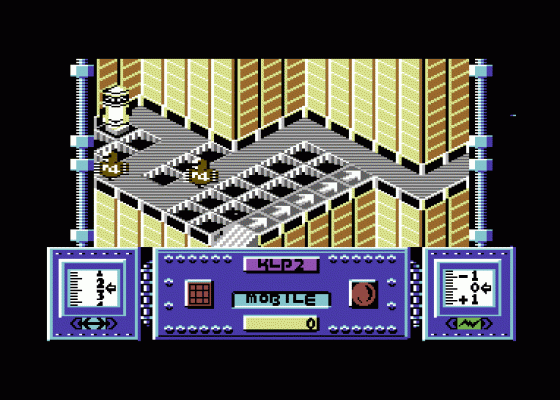Magnetron
Planet Quartech is being menaced by eight droid-controlled satellites, and the player's KLP-2 droid has been assigned to disable each one by shutting down or overloading their reactors.
The action is displayed in 3D isometric style, with each satellite consisting of a network of flick-screen landscapes. These comprise six basic elements: flat squares, magnets, ramps, teleports, computer access ports and reactor areas.
Computer access ports reveal three icons: sphere, droid and box. The sphere icon displays the satellite reactor status, showing their relative charge if stable; the droid reveals the KLP-'s current status and its components, and box shows data sheets on weapons and devices, but only when the required security class is held.

Reactors consist of four containers, each holding a fuel rod (positive) or an inhibitor (negative). Either component can be removed and replaced by the rod currently held by the droid; if KLP-2 isn't carrying a rod, the gauge registers zero. A reactor is disabled by decreasing its total charge to below one, shutting it down, or increasing it to above five, which overloads the system. Either extreme destabilises it, and once all four are disabled the satellite itself shuts down. Teleports are then activated allowing access to the remaining satellites.
The reactors are guarded by sixteen types of droid which are destroyed or grappled with. Grappling transfers all the abilities of the dismantled droid to the KLP-2. If this improved droid is deactivated, the last shell is reinhabited, and the mission continues. Once this shell is destroyed, however, the game ends.
Grappling involves aligning three sets of three icons within a time limit, which varies according to the relative strengths of the two droids involved. If successful, transfer of the enemy droid's components is initiated. If unsuccessful, a detonator is activated destroying the shell.

KLP-2's movement is affected by the charges it picks up from the reactors. At the bottom left of the control panel, the combined weight of droid and rods is indicated; if the droid is too heavy, ramps are tougher to climb and steering is more awkward. Magnets (displayed as arrows) respond to whether the droid is positively or negatively charged, assisting or hindering progress respectively. The charge is continually displayed in the bottom right of the screen display.
Landscapes increase in difficulty and droids grow more powerful as the satellites are cleared. Once the series of eight has been shut down, another cluster appears, with an increased number of more aggressive droids.
GH
Despite the altered scenario, this is very much the ageing classic Paradroid turned on its side. This familiar gameplay conspires with the lack of graphical and aural difference to create a playable but ultimately unsatisfying game.

Graphically, it's just been upgraded to 3D, with some neat, solid-looking landscapes and an impressive three-layer parallax starfield. Unfortunately, it falls into an uninspiring middle ground between sombre menace and appealing colour.
In this respect the sound is equally lacking: the robotic effects are good but fail to be great, and the spot tunes tend to detract from the atmosphere and becomes quickly annoying.
As always from Graftgold, the presentation is excellent, with a nuts 'n bolts screen display and great attention to detail throughout.

Nonetheless, the lack of diversity soon becomes apparent: the same screens reappeaar, the sub-games, although initially compelling, are unsophisticated, and the lack of atmosphere reduces it to tedium. As it stands, Magnetron is good... but not *that* good.
SJ
Take the Spectrum game Quazatron, add a good dose of Paradroid and some derivative sub-games, and voila! Magnetron appears.
This flick-screen, 3D version of the Braybrook classic is very nicely executed, and is as entertaining as its predecessor(s) to play. Unfortunately, the factors that make it playable also provide the very reason for not buying it: if you've got Paradroid, you won't need this; if you haven't got Paradroid, it stands a good chance you don't like this style of game anyway.

The level of imitation even descends to the Paradroid character set and Michael Winterberg-style soundtrack which is very reminiscent of earlier Graftgold pieces, containing deja vu snatchers of Morpheus and Ranarama. The occasional jingles do little to emphasise the atmosphere and become increasingly intrusive as play progresses.
When all is said and done, Magnetron *is* a good game and carries a decent price tag, but comes recommended only for newcomers to the genre.
JR
Why Graftgold have decided to squander their talent producing this poor Paradroid derivative is a mystery to me, especially as Paradroid is such a perfect program.
The graphics are surprisingly poor, and fail to spark any sort of atmosphere. The robot sprites lack detail and definition, and in some places the use of colour is very gaudy indeed, making the game unattractive to the eye.
The very high difficulty level is immediately off-putting - the first couple of games are frustratingly short, and it takes quite a while to get the hang of things.
Each level is relatively small, and once you're proficient at the transfer game, I don't think it'll take long to go through all eight.
Magnetron is a great disappointment. If you want a Paradroid game, you might as well buy the real thing - it's prettier, plays better, is more varied and is much cheaper.
Verdict
Presentation 84%
Comprehensive instructions, neat range of options and informative screen display.
Graphics 70%
Convincing, although frequently drab, backdrops. The sprites are less effective, however, and the 3D movement occasionally flawed.
Sound 56%
Paradroid-like noises and some annoying jingles.
Hookability 71%
Difficult from the outset, and gets harder.
Lastability 51%
The lack of graphic variety and repetition of tasks quickly dampen the fun.
Overall 67%
A beautifully presented game marred by its derivative gameplay and lack of diversity.
Other Reviews Of Magnetron For The Commodore 64
Magnetron (Firebird)
A review
Magnetron (Firebird)
A review by Bohdan Buciak (Commodore User)


 1st April 1988
1st April 1988

